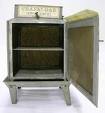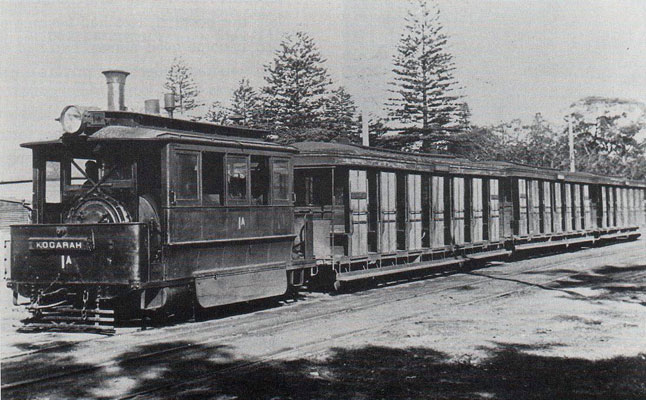Dear Donald,
Every year we get an annual report from Angie, the Jerrems family guardian angel. If you recall her mission is to keep you from doing anything
incredibly stupid.
In addition she tries to keep track of Old Ray, the family Ghost, who makes
prominent appearances around the world. Stay tuned for next month’s report from Angie.
| THE SASSALL FAMILY STORY (PART 2) |
Ray Jerrems, Our Genealogist, Historian
Filling in the branches of the Family Tree

Introduction
This article continues my story of the life and family of my great grandparents Alfred (Fred) and Susannah Sassall, the parents of Esther Muriel Jerrems (the wife of my grandfather Ernest Alfred Jerrems).
In the first Part I told you about the early lives of Fred and Susannah, their personalities, their environment in Lithgow, and Graham Harmer described their house. I concluded the Part with an account of the sad death of George Robert Sassall, one of Fred and Susannah’s sons, in a blast furnace accident.
In this second Part for the first time I have taken the opportunity to paint a picture of the day-to-day lives of people in the late 19th Century up to the First World War. We have a number of anecdotes, we see Fred and Susannah move to Sydney, and we see summaries of the later lives of the children.
A woman’s work is never done
Having observed my grandmother Esther (Susannah’s eldest daughter) in action in the 1940s and 1950s as a housewife, and having talked recently to my mother-in-law (Nancy) at some length (she was born in the famous Victorian goldmining town of Ballarat in 1912, 3 months after the Titanic was sunk) I have a healthy regard for the work carried out by housewives in the 19th Century and the early 20th Century.
To state the obvious, the households did not have electric lighting or power, heating (apart from open fireplaces), refrigerators, freezers, vacuum cleaners, washing machines, dryers, dishwashers, cake mixers, blenders, microwaves, or gas or electric stoves and ovens.
Obviously the volume of work undertaken by housewives varied according to the number of members in a family and their ages, but the number of responsibilities remained much the same. In Susannah’s case she had at least 13 children in her care, but they were spread out over 23 years, and the first two children were girls who would have helped later with looking after the younger children. Despite this Susannah would have been very busy for many years (for instance, when Audrey turned 17 her mother would have looked after children for a total of 40 years). Here is a typical week for a housewife in those days, confirming the stories we hear about how hard they worked:
Monday-washing day. Wash everybody’s clothes, towels, washers, bed linen, tea towels, table cloths etc, with extras like curtains (particularly in dusty Lithgow) included periodically. Involved boiling up fuel copper a number of times, wringing out washing, hanging it out on clothes line, and starching selected items (shirt collars and cuffs, and the fronts of dress shirts).
Tuesday-ironing day. Heat iron on stove, iron the washing which needed ironing (most of it).
Wednesday-cleaning day. Scrub floors, dust and polish furniture, shake mats and rugs, clean windows periodically, sweep paths, polish silverware.
Thursday-sewing day. Catch up with sewing, darning, knitting, crochet and embroidery (possibly with friends), dressmaking, clothesmaking etc.
Friday-cooking day. Cook cakes, scones, biscuits, puddings, pastries etc for weekend and following week. Cook jams, preserves and pickles in season.
Saturday-prepare breakfast for all, wash up dishes, bath the children (water may have been heated by chip heater, if no chip heater then in copper), cook hot lunch , wash up dishes, clean fuel stove, prepare afternoon tea and evening meal.
Sunday-prepare breakfast, wash up, dress self and children for church and Sunday School, prepare hot roast dinner or (in summer) serve corned beef. Afternoon-visit friends and relatives or entertain friends and relatives. Prepare evening meal.
Every weekday: Prepare breakfast for all, clean shoes and boots, pack lunches for people needing them, wash up dishes, cook lunch for schoolchildren coming home for lunch, wash dishes, clean fuel stove (empty ashes, polish stove with black lead), provide afternoon tea for school children, prepare dinner for all. Tend chooks and garden. Do shopping and arrange deliveries from butcher and baker (fruit and vegetables were usually delivered by Chinese market gardeners). Check toilet paper (strips of newspaper, no fancy soft tissue in those days!) in the outhouse “dunny” (a “long drop” unless the local Council had a sewerage collection service, in which case there was a large drum). Check water supply in Coolgardie Safe.
Coolgardie Safe(pictured below)
The famous Coolgardie Safe forms part of Australia’s history and folklore. Named after a gold mining town in West Australia where it was invented in the 1890s by A.P. Mccormick, this type of system was probably also used in other countries. Before ice chests were invented it was the only cooling system available for food. Graham describes a “Rolls Royce” version built by his stationmaster father at Boppy Mountain on the sun scorched western plains of NSW:
“It consisted of a timber framed cabinet about 2ft wide by 2ft deep by 6 ft high with legs approximately 9 inches high with a hinged door at the front. The enclosed cabinet portion was covered in a fine zinc wire mesh and on top of the cabinet sat a tray about 2 inches deep which was filled with water. Fixed in the tray and draped over the four sides were four hessian bag curtains which absorbed the water in the tray and became saturated. The moisture in the curtains continually evaporated (most effectively when there was a breeze) reducing the internal temperature of the safe and food in it.”
Cleanliness is nigh unto godliness
Like their mother Susannah, the Sassall daughters subscribed to this adage. They had a reputation for being meticulous housewives. My Aunty Vi told me the story of how they all scrubbed their doorsteps and (as one would expect) had a doormat at the front and back doors. However (according to the story) in later life one of the Sassall daughters had a mat at the back gate to ensure that tradesmen and deliverymen wiped their feet before walking down the path. My vague recollection was that it was Graham Harmer’s mother Audrey, but Graham assures me that it was much more likely to be Clara or Lucy.
Perhaps it was in fact Clara in Lithgow. In his memoirs the late Allan Cargill said:
“I spent a number of “enforced holidays” with Aunty Clara, who was known in the Durie family [ie her husband Fred’s family] as “Aunty Fuss”. You could break your arm if you fell on the glazed polished floors….”.
Baths at the Zig Zag Colliery
Speaking of cleanliness, Fred Durie was the engineer at Zig Zag Colliery, as referred to in the first Part of this article. When the Jerrems nieces and nephews visited Clara and Fred from Sydney they sometimes had a hot bath at the Colliery. This was quite an event because the Colliery had huge hot communal baths which the miners used at the ends of their shifts. For the children this was a vast improvement over the small tub used at their home, and they had great fun playing in the baths.
The Sassall School of Cooking Excellence
Once again, like their mother Susannah, the Sassall daughters were magnificent cooks. They seemed to have unofficial cooking competitions between themselves. My father would delight in telling the story of one of his uncles (we are not sure which uncle) who, when his Sassall wife produced for visitors a table groaning under the load of cakes and delicacies, used to quip “Take it easy folks, we have to eat for the rest of the week”. To make it worse for the uncle, when he was in his forties his doctor ordered him to stop eating rich food! I used to love visiting or staying with my grandparents because “Nana” (Esther) would pride herself on having at least three types of cakes or cookies at every main meal. When she made my school lunch it was a feast!
Coolgardie Safe


The family leave Lithgow in 1916
The McCall bakers moved to Hurstville before the First World War and Fred got work with his son-in-law Fred Durie as a fireman on the boilers at the Zig Zag Colliery. However Fred’s eyesight failed in 1916 due to glaucoma and Fred, Susannah and the younger children Lucy, Baden, Allan and Audrey moved to the developing Sydney suburb of Ramsgate.
It would be difficult to imagine a greater contrast between the localities of Lithgow and Ramsgate, they were like chalk and cheese. Unlike the Lithgow area, the Ramsgate area (including the adjacent areas of Sans Souci, Kogarah and Rockdale), on the western shore of Botany Bay, is as flat as a billiard table, and the climate is mild. Possibly the area was chosen because it was suitable for a blind person. Coincidentally, one of my grandfather’s brothers (Charles) moved to this area at a similar time, and his descendants (including our reader Laurel) grew up there.
Transport to the area was simple, via the main Sydney to Sutherland train line and connecting steam trams. Perhaps the “door to door” tram service was overdone at times, because on one occasion a tram left its tracks on Rocky Point Road in Ramsgate and finished up in the backyard of May Pillans (nee Sassall), no doubt causing consternation to the passengers and the locals.
A downside of the steam trams was that they blew out hot cinders. Graham’s late mother Audrey related to him that if the women passengers were wearing white clothes or their clothes had fine material they would put up umbrellas to keep the cinders at bay!
The house at 10 McDonald Street Ramsgate was less than a kilometre (half a mile) from the Bay and was popular with visitors who were fond of swimming, like my grandfather and his four children.
Fred and Susannah were surrounded by family in their 30 years at Ramsgate and they had a very happy retirement.
Fred died in 1947 at the age of 90 at Ramsgate and Susannah died in 1951 at the age of 86 at Lucy’s house, in (perhaps fittingly) Lithgow.
The family left behind in Lithgow
This is a brief account of the children who did not accompany Fred and Susannah to Ramsgate in 1916, in order of age:
(1) Esther (my grandmother) born in 1885, married Alf Jerrems in 1906 and lived the rest of her life in Greenwich, a harbourside suburb of Sydney.
(2) Clara Maude (“Clara”) born in 1886, married Frederick James Durie, the engineer at the Zig Zag Colliery. When the colliery closed down in 1932 as a result of the Great Depression they moved to Port Kembla on the NSW South Coast where he worked at the steelworks.
(3) George Robert born in 1888, killed in furnace accident (see previous article). There are numerous descendants of his son of the same name living in the Wollongong area on the NSW South Coast. They are the only descendants carrying the Sassall surname.
(4) Alfred (“Alf”) Enoch born in1890, married Rosa “Queenie” Victoria Coombes in 1916, worked at Small Arms Factory, migrated to South Africa after the First World War. Descendants live in South Africa.
(5) Mabel (“May”) Constance born in 1892, married John Pillans, a linotype operator. The family stayed in Lithgow until John obtained employment with the Daily Mirror/Truth in Sydney and then moved to the Sydney suburbs of Ramsgate, Greenwich and Cammeray. The Pillans family was prominent in Lithgow (see below).
(6) Amy (“Amy”) Agnes born in 1897, married Ernest (“Ern”) William Young, a former apprentice at the Hoskins Steelworks in Lithgow. Family lived in the Sydney suburb of Canley Vale until 1940 where Ern was employed at the Randwick Tramway Workshops and then moved to Sans Souci (near Ramsgate) where Ern owned and operated a woodturning business. They retired to Shoalhaven Heads on the NSW South Coast. One of their sons (George) is still living (aged 91) and lives on the NSW North Coast. George’s daughter is our reader and contributor Helen Foster.
The Pillans family
May Sassall’s marriage to John Pillans brings me to the Pillans family, which was prominent in Lithgow for many years. Robert Pillans Snr was the father of John Pillans. Robert was Mayor of Lithgow 3 times, the first in 1911. While he was a prominent unionist and Labour party member he was highly respected by both employers and employees alike in Lithgow and his negotiating skills were regularly acknowledged in the Lithgow “Mercury” newspaper.
Probably the only modern-day public evidence of the family is Lake Pillans (now called a Wetland) near the site of the Hoskins steelworks. The lake, named after Robert Pillans Snr, was originally established as a cooling pond for the blast furnace/steelworks complex. Descendants are in NSW and Canberra.
Up the apple tree
This leads me rather nicely to the story (as told to me by my Aunty Vi) of how May Sassall met John Pillans.
John (according to the story) was working for a Lithgow newspaper and was asked to find out the time and date of the impending wedding of my grandparents Alf and Esther. John went to the Hassall house and saw a girl in an apple tree in the front yard. The girl identified herself as May Sassall and declared that she knew all about the wedding and was in fact to be one of the bridesmaids. Eleven years later May and John were married.
This could scarcely be called a lightning romance!
As with many stories I have been told, I have tended to take this story with the proverbial grain of salt. Amy and John were born in 1892, so they would only have been 14 at the time. Perhaps he was an apprentice? Certainly he was later a linotype operator.
In any case it makes a romantic story.
Born an aunt
Which daughter of Alfred and Susannah was an aunt when she was born? Does this sound like a conundrum?
The answer is “Audrey” (Graham Harmer’s mother). The reason is that Audrey’s oldest sister Esther (my grandmother) had her first daughter Esther (“Essie”) on 12th February 1908. Audrey was born a little over a month later on 18th March 1908. This meant of course that when Audrey was born she was Essie’s aunt. Easy? It also meant that when Essie’s younger sister (Violet) was born in 1909 Audrey was her aunt also, and of course she was my father’s aunt also.
This was a standing joke in the Sassall and Jerrems families. Essie and Violet spent many happy hours in later years playing with their Aunty Audrey.
The Sassall children at Ramsgate grow up
Here is a summary of the children who originally accompanied Fred and Susannah to Ramsgate:
(1) Lucy born in 1898, married William James Cargill in 1922, family returned to Lithgow after marriage at Kogarah (Bill had moved to Lithgow when the Small Arms Factory opened in 1912, serving his time as a Toolmaker, later rising to a senior management level). Lucy was tall (at least to a small boy like me) and striking. She seemed to like small boys (like me) and was an excellent cook, so we got on famously.
(2) Baden Powell born in 1900 on the day of the Relief of Mafeking in South African Boer War, worked for while at Small Arms Factory, married in 1928 to Daphne Witcher, lived at Sydney suburbs of Kogarah (near Ramsgate), Ramsgate, Bexley, Peakhurst and then Balgownie (near Wollongong).
(3) Allen Warren born in 1904, married in 1939 to Lillian Smith, at early stage worked in the Small Arms Factory. The family lived in Ramsgate, Edie Creek, New Guinea, Lithgow (SAF), Mortdale (Sydney).
(4) Ethel Audrey (“Audrey”) born in 1908, married in 1937 to Harry Edwin (“Ted”) Harmer. The family lived at numerous widespread rural addresses (Murrurundi, Llangothlin, Boppy Mountain, Sodwalls and Katoomba) because Ted was a NSW Railways employee. Son Graham is a reader of the Journal and a contributor to this article.
Alfred Sassall’s reaction to blindness
Alfred was about 60 years old when he turned blind, and he died at the age of 90, so, to state the obvious, he had plenty of time to adapt, compared with relatives who lost their sight at a later age (for instance my great grandfather Charles Jerrems).
Graham Harmer referred to Fred’s blindness in the first Part of this article.
The fact that Alfred learned and then taught Braille is indicative of his high degree of adaptation. The late Allan Cargill (son of Lucy) had the following further comments about Alfred (his grandfather):
“I used to take him for walks; he knew every fence and tree in Ramsgate, and could tell what coins he had in his hands (don’t try to pass a penny for a two shilling coin)!
Shortly before he died I visited one afternoon. There were two gates on the side passage, nobody used the front door. When I arrived at the back door there was a fierce argument between Alf and Susie as to who was coming. Alf maintained Allan Cargill. He was right, he knew everyone’s footsteps and how they manipulated the side gates!”
Conclusion
Looking back, it seems slightly surreal to me that before Graham Harmer emailed me on 7th February this year I knew very little about the Sassall family, but now I have heaps of information from Graham and Helen Foster (both amateur historians), Allan Cargill’s memoirs, and books like “Furnace, Fire and Forge” giving the history of the iron and steel industry in Lithgow.
You will be hearing more stories from me!

